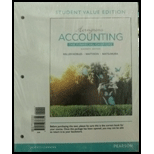
Concept Introduction
Transfer Pricing: Transfer Pricing refers to setting the price (known as transfer price) at which the related divisions of a company transact with each other.
1.
The total contribution margin for Costa Company for the quarter.
2.
To Compute: The total contribution margin for Chair Division and Cushion Division and the company on assuming that the Chair Division purchases the 1,800 cushions needed from the Cushion Division at its current sales price.
3.
To Compute: The total contribution margin for Chair Division and Cushion Division and the company on assuming that the Chair Division purchases the 1,800 cushions needed from the Cushion Division at its current variable cost.
4.
The best option out of the three options as shown in Requirements 1, 2, and 3 for Costa Company.
5.
(i)
The transfer price that Costa Company should set when the Cushion Division has capacity of 3,600 cushions per quarter and can continue to supply its outside customers with 1,800 cushions per quarter and also supply the Chair Division with 1,800 cushions per quarter.
(ii)
To Compute: The total contribution margin for the quarter for the company, using the transfer price that is determined in above part (i).
Want to see the full answer?
Check out a sample textbook solution
Chapter 24 Solutions
Horngren's Accounting, The Financial Chapters, Student Value Edition (11th Edition)
- what is the materials quantity variance?arrow_forwardOn January 1, 2012, Penn Manufacturing purchased equipment for $865,000, having a useful life of 8 years and an estimated salvage value of $62,000. Penn has recorded monthly depreciation of the equipment using the straight-line method. On December 31, 2018, the equipment was sold for $295,000. As a result of this sale, Penn should recognize a gain of ___.arrow_forwardoperating laverage is 3.5?arrow_forward
- What is depreciation, and why do companies apply it to fixed assets? Discuss at least two methods of calculating depreciation and how they affect a company’s financial reporting over time. Need answerarrow_forwardWhich account is not closed at the end of an accounting period? Consider typical accounts maintained in the general ledger. (A) Sales (B) Wages Expense (C) Capital (D) Rent Revenue HELParrow_forwardCurrect answerarrow_forward

 AccountingAccountingISBN:9781337272094Author:WARREN, Carl S., Reeve, James M., Duchac, Jonathan E.Publisher:Cengage Learning,
AccountingAccountingISBN:9781337272094Author:WARREN, Carl S., Reeve, James M., Duchac, Jonathan E.Publisher:Cengage Learning, Accounting Information SystemsAccountingISBN:9781337619202Author:Hall, James A.Publisher:Cengage Learning,
Accounting Information SystemsAccountingISBN:9781337619202Author:Hall, James A.Publisher:Cengage Learning, Horngren's Cost Accounting: A Managerial Emphasis...AccountingISBN:9780134475585Author:Srikant M. Datar, Madhav V. RajanPublisher:PEARSON
Horngren's Cost Accounting: A Managerial Emphasis...AccountingISBN:9780134475585Author:Srikant M. Datar, Madhav V. RajanPublisher:PEARSON Intermediate AccountingAccountingISBN:9781259722660Author:J. David Spiceland, Mark W. Nelson, Wayne M ThomasPublisher:McGraw-Hill Education
Intermediate AccountingAccountingISBN:9781259722660Author:J. David Spiceland, Mark W. Nelson, Wayne M ThomasPublisher:McGraw-Hill Education Financial and Managerial AccountingAccountingISBN:9781259726705Author:John J Wild, Ken W. Shaw, Barbara Chiappetta Fundamental Accounting PrinciplesPublisher:McGraw-Hill Education
Financial and Managerial AccountingAccountingISBN:9781259726705Author:John J Wild, Ken W. Shaw, Barbara Chiappetta Fundamental Accounting PrinciplesPublisher:McGraw-Hill Education





